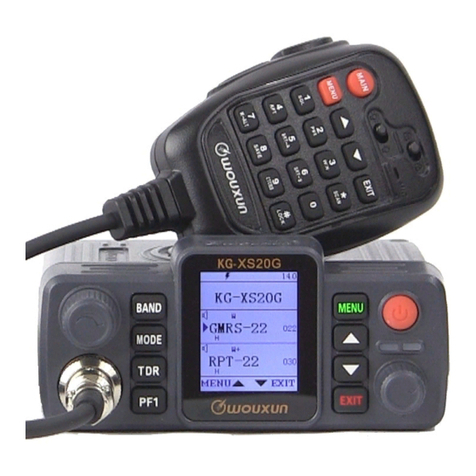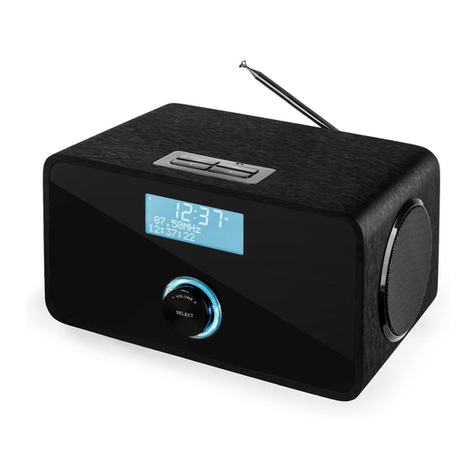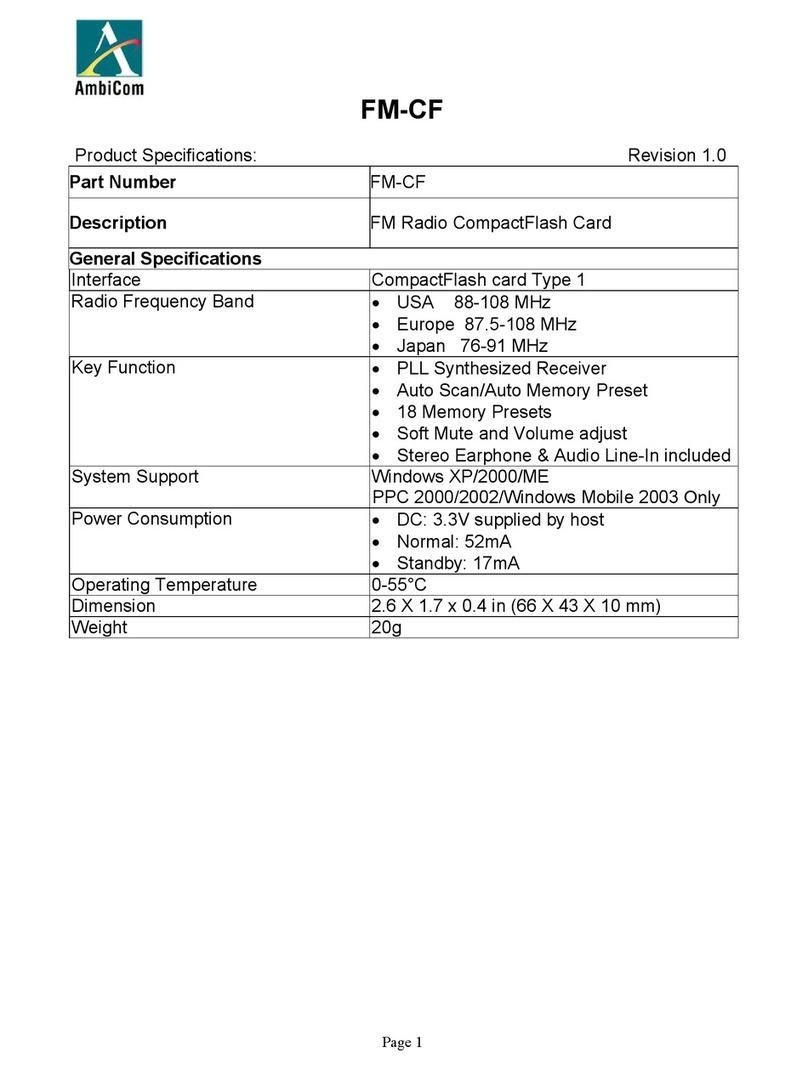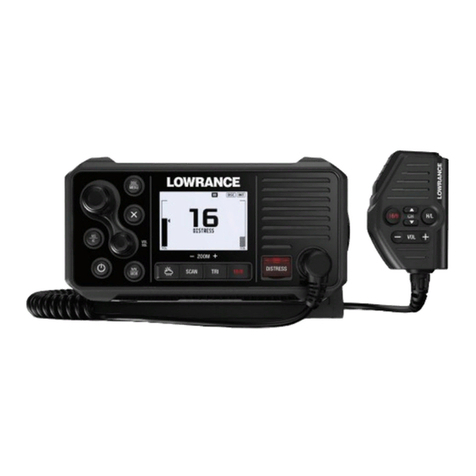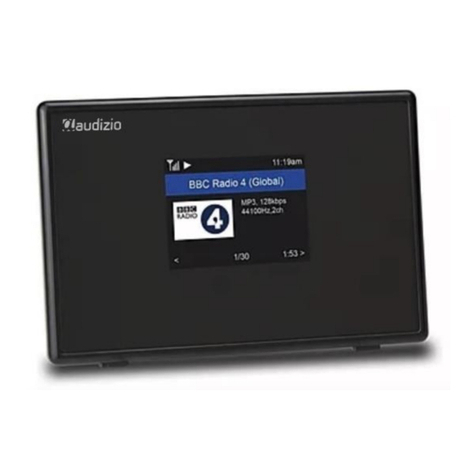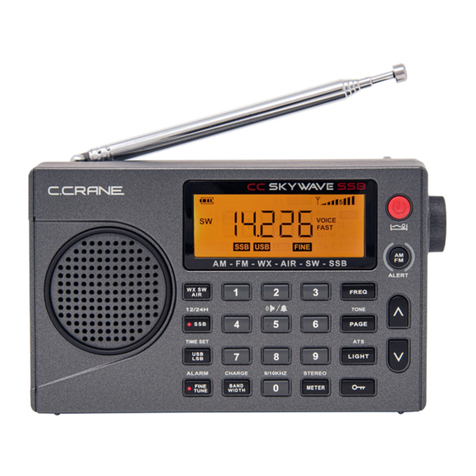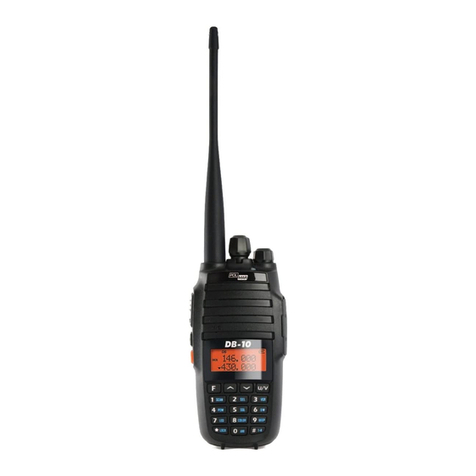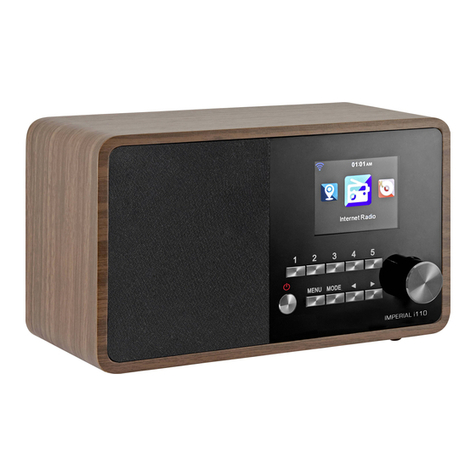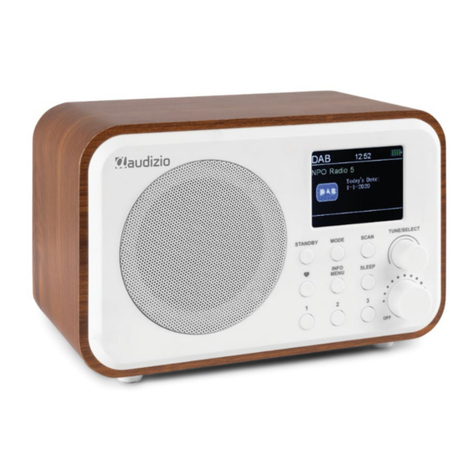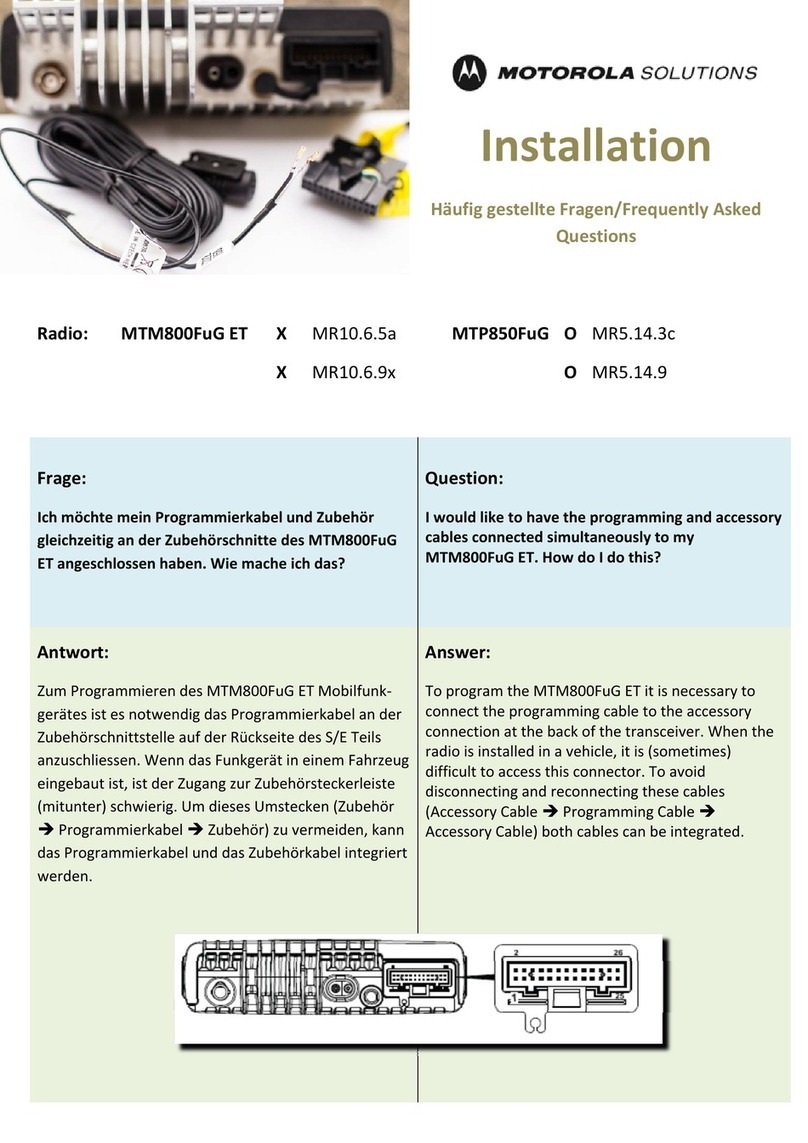Graybar 600 Operating and maintenance manual

RADIO
GRAYBAR600
SERVICE NOTES and
REPLACEMENT PARTS
,......
..,..,
,
,
.4
-,
----=------ -
-).
i- -
GraybaR
ELECTRIC COMPANY

AA+

CONTENTS Page
Introduction_ 5
Radiotron Sequence .7
Service Data Chart.... 39
Replacement Parts 40, 41, 42
PART I -INSTALLATION
Antenna (Outdoor Type)
Antenna (Indoor Type)
Special Antenna Installations for Noisy
Locations
Ground
Radiotrons
Receiving Loud Local Stations.
Page88
8101011
Page
Adjustment for Low Line Voltages__ ___ 12
"Local -Distant" Switch________ ..... .... 12'
Jerky Action of Station Selector................._______ 12
Installation of Pilot ...... 12
Phonograph Pick -Up.... 13
Location of Receiver in Room. 13
Knobs 13
PART II -SERVICE DATA
Antenna System Failures
Radiotron Sockets
Radiotron Prongs
Loose Volume Control
Broken Condenser Drive Cord
Radiotrons Fail to Light When Operating
Switch Is "On" ___-_____ ..... ...... 15
Plates of Radiotron UX-280 Excessively Hot 15
No Signal-Radiotrons 0 K. 15
Hum 16
Low Volume 16
Audio Howl 17
Acoustic Howl .. 17
Distortion in Reproducer Unit Only 18
14 Adjustment of R.F. Compensating Con -
14 denser - 18
14 Distorted Reproduction Caused by Other
14 Than Reproducer Unit - 18
14 Adjustment of I.F. Transformers 19
Adjustment of Oscillator Trimming Con -
Testing Electrical Alignment of Tuning
Condensers
Audio Transformer and Receiver By-Pass,
Condensers
Output Condenser, Output Choke and Filter
Condensers
Reproducer Unit ..
Centering Cone of Reproducer Unit
PART III -ELECTRICAL TESTS
Voltage Supply System 25
Voltage Readings at Terminal Strip 25
Voltage Readings at Radiotron Sockets 25
Methods for Continuity Tests 26
Receiver Assembly Continuity Tests 29
Socket Power Unit Continuity Tests _
Checking Resistance Values
Testing By -Pass Condensers
Testing for Grounded Parts in Receiver
Assembly
PART IV -MAKING REPLACEMENTS
Replacing the Volume Control
Replacing R.F. Transformer and Oscillator
Assembly
Replacing Radiotron Gang Sockets
Replacing Main Tuning Condensers and
Drive
Replacing Condenser Drive Cord ...........
Replacing R.F. Compensating and Oscillator
Trimming Condensers ... ...... .......... ....... 34
Replacing the Audio Transformer and By -
Pass Condensers ..... ....... _ ...... ....... ......
Replacing Perforated Dial Scale
Replacing Power Cable
Replacing Intermediate Transformers
Model No. 600 Receiver
Rear Interior Cabinet View
Top View of Receiver Chassis
Top View of S.P.U. 6
Radiotron Sequence 7
Sub -Chassis View of Receiver 9
Schematic Circuit of No. 600 Receiver 10-11
Dial Screen, Tuning Scale, and Pilot Lamp 12
Schematic of Phonograph Pick -Up 13
Tuning Condenser Drive Cord 14
Non -Metallic Screw Driver .15
Adjusting Compensating and Oscillator Trim-
ming Condensers 15
175 K.C. Test Oscillator 17
Adjusting I.F. Tuning and Neutralizing.
Condensers 19
21
22
23
232424
303131
31
32 Replacing Tapped Resistance Unit in Receiver
Assembly
33 Replacing Miscellaneous Parts in Receiver
33 Assembly
Replacing Cone of Reproducer Unit
34 Replacing Output Transformer
34 Replacing Filter Condensers, Output Con-
denser and Output Choke
Replacing Power Transformer or Filter Re -
35 Replacing Terminal Strip on S.P.U. or Re -
35 ceiver Assembly
35 Replacing Miscellaneous Parts in S.P.U.
36 Replacing Front Grill Panel or Cloth...._....-...........
ILLUSTRATIONS
145
36
363637
37
37
383838
I.F.Condenser Adjusting Screws 21
Adjusting Oscillator Trimming Condensers 22
Aligning Tuning Condensers 23
Aligning Tool 23
Centering Cone ,24
Schematic of Voltage Supply System 25
Internal Connections of Audio Transformer
and By -Pass Condensers 26
Internal Connections of Output Choke, Out-
put Condenser and Filter Condensers . 26
Cable Connections 27
Receiver Sub -Chassis Wiring Diagram .........-. .... 28
S.P.U. Wiring Diagram 30
Removing Reproducer from Cabinet.. 32
Removing Receiver from Cabinet 33
Removing Grill Panel from Cabinet 35
3

SOCKET POWER
UNIT
SPARE PILOT
LAMP SOCKET
ANTENNA AND
GROUND
BINDING POSTS
Figure 1-Rear interior cabinet view showing
location of main assemblies
4
DYNAMIC REPRODUCER
ASSEMBLY
RECEIVER CHASSIS
ASSEMBLY

Grayb aR
No. 600 RECEIVER
SERVICE NOTES
INTRODUCTION
The Graybar No. 600 receiver is a seven -tube socket powered console cabinet model
radio receiver utilizing the Super -Heterodyne circuit in its highest development, and em-
ploying six UY-227 Radiotrons and the newly developed power amplifier Radiotron, UX-245.
The Radiotron UX-280 is used in a socket power unit for supplying all plate, grid, and
cathode voltages as well as supplying a high D.C. voltage for the newly developed high
voltage, low current dynamic reproducer field used in this receiver. Incorporated in this
receiver are the latest developments in Super -Heterodyne engineering in addition to other
perfected features such as one -dial control, complete A.C. operation, power detection, single
audio amplification stage, with overall balance in sensitivity, selectivity and tonal quality
that can best be accomplished in a Super -Heterodyne. Figure 1 illustrates a rear view show-
ing the principal parts. Figure 2 illustrates the top view of the receiver chassis, and Figure
3 is a view of the socket poiyer unit.
PERFORAtED CELLULOID
DIAL DIAL SCREEN
STATION
SELECTOR DRIVE
ANTENNA AND
GROUND LEADS
PILOT GANG CONDENSER A. F. TRANSFORMER AND
LAMP ASSEMBLY BY-PASS CONDENSERS
CABLE TO S. P. U.
SERIAL R. F. COMPENSATING SERIES OSCILLATOR PARALLEL OSCILLATOR PHONOGRAPH PICK-UP
NUMBER CONDENSER TRIMMING COND. (600 K. C.) TRIMMING COND. (1400 K. C) TERMINAL STRIP
Figure 2-Top view of receiver chassis showing principal parts
The No. 600 receiver is designed to operate on alternating current of 105 to 125 volts,
50 to 60 cycles as used for house lighting. Connection to D.C. lines or to A.C. lines of
different rating may damage the receiver or the Radiotrons.
This receiver is also made in models designed for alternating current operation of 105
to 125 volts, 25 to 40 cycles. In this model the power transformer is different from that
used in the 50-60 cycle models. All other parts are identical in both models and the Service
Notes apply to each equally well.
The following circuit characteristics are incorporated in the No. 600 receiver:
(a) The six UY-227 Radiotrons and one UX-245 Radiotron are connected in a seven -
tube super -heterodyne circuit with a UX-280 Radiotron in the S.P.U. for plate,
grid, and cathode voltage supply as well as high voltage, low current supply to the
field of the new dynamic speaker.
5

55
The super -heterodyne circuit consists of one tuned R.F. stage; tuned fitst de-
tector; two intermediate R.F. stages; an oscillator; a second, or power detector;
and the single audio stage using the recently developed power amplifier litictiotron
UX-245. The Radiotron sequence is shown in Figure 4. 4
(b) A "Local -Distant" antenna switch is incorporated in this receiver which permits
better control of volume with less distortion, due to the natural condition of over-
loading on extremely loud local signals together with better selectivity on local
stations. This feature with the use of a high impedance semi -tuned primary induct-
ance of the tuned R.F. stage permits the use of a varying length of antenna without
materially affecting the tuning of the receiver.
(c) The intermediate radio frequency (referred to as I.F.) which results from the
mixing of the incoming modulated radio frequency current with that of the local
oscillator is 175 K.C. The audio, or voice, modulation that is present in the radio
frequency is carried on through the first detector and in the mixing is impressed
on the I.F. After being amplified in two I.F. stages it is detected, or rectified, and
POWER OUTPUT CHOKE, OUTPUT CONDENSER,.
TRANSFORMER AND FILTER CONDENSERS FILTER
REACTORS
TERMINAL
STRIP
A. C. POWER INPUT UNE UK -280 OPERATING
(PLUG NOT SHOWN) SOCKET SWITCH
Figure 3-Socket power unit showing
principal parts
further amplified in the audio amplifier stage using the new Radiotron UX-245.
'I'he use of 175 K.C. for the I.F. prevents serious harmonic disturbance around
550 K.C., which is a distinct asset. The super -heterodyne circuit owes its superior
selectivity and sensitivity to tuned I.F. amplification, for no matter what the R.F.
frequency may be to which the receiver may be tuned the most part of the over-all
amplification is accomplished by the uniform amplification of the I.F. stages. These
I.F. stages are also constantly neutralized for 175 K.C. Neutralization, or preven-
tion of oscillation, is then independent of the broadcast frequency, which is prac-
tically the ideal condition for radio reception. The I.F. transformers are sharply
tuned to give improved over-all selectivity. The tonal quality is maintained by
means of certain refinements in the circuit arrangement, especially at high fre-
quencies.
(d) The second detector operates at 235 volts plate potential with proper grid bias.
The high plate voltage used gives sufficient undistorted output to operate the single
audio power stage using the UX-245 Radiotron directly from the second detector,
thus eliminating any possible distortion that might be caused by an intermediate
audio stage.
(e) Use of the UX-245 Radiotron with the new dynamic speaker permits an undistorted
output which represents an over-all gain over previous receivers. It uses the same
6

( f )
(g)
voltage on its filament as the UY-227, and plate and grid voltages that fall within
the supply limits of a UX-280.
The volume control regulates the grid bias on the tuned R.F. stage and the first
I.F. stage. When loud local signals are received the "Local -Distant" switch in the
local position acts very effectively in allowing better control of volume near the
maximum volume control setting without over -loading the receiver. The volume,
when the over -loading point is reached, will, of course, distort and drop to a small
value. This is entirely natural to the over -loading condition in a vacuum tube, as
is also the two peaked tuning effect, which is obtained when the dial is detuned to
either side of the normal peak setting with resultant less input and hence no over-
loading.
The use of a high voltage, low current field in the dynamic loudspeaker employing
the 8 -inch cone makes a sensitive reproducer with a field that is supplied by the total
D.C. voltage output of the UX-280 in the S.P.U., drawing only approximately 46
milliamperes at about 300 volts. This load together with the receiver Radiotron load
is much below the load limit of the UX-280. The voltages on the plates, as well as
the grid voltages of the R.F. and I.F. Radiotrons, are purposely reduced to make no
over-all difference in amplification, but permitting better S.P.U. regulation and
stabler operation. Proper cathode voltages are supplied to all the UY-227 Radio -
FROM ANTENNA
32
POWER 2.20iTPWR.) OSC. 2W F. LE I. F. TUNED IL' TUNED
A. F. DET. R. F.
RADIO FREQUENCY CURRENT
-- - OSCILLATOR
TO R. F. CURRENT IN INTERMEDIATE STAGES
LOUDSPEAKER A. F CURRENT
Figure 4-Radiatron sequence
trons to secure quiet operation and insure average Radiotron life. For the most
part, the series or parallel resistance method of supplying voltages is used. The
line voltage adjustment switch, common in most receivers, has been discarded to
make necessary a more careful check of the supply line voltage before making any
change. A tap has been provided in the power transformer primary, located under
the S.P.U. for lower than 115 -volt power supply to which a soldered connection can
be made. This will prevent frequent change -over in the power supply and thus
will lessen the application of excessive filament voltages.
Mechanical and electrical improvements not mentioned above are :-
(a) Use of "Isolantite" for I.F. transformer adjustable condenser and coil mounting,
and also the R.F. compensating and oscillator trimming condenser mounting.
(b) Accessibility of I.F. adjustments. See Part II, Section 16.
(c) Electrostatic shielding between R.F. condensers of the gang tuning condenser and
also between socket power unit and receiver chassis.
(d) Simplified construction of the S.P.U.
(e) Projection type of dial scale with kilocycle designation is distinctly a new feature.
(f) A terminal strip is provided for convenient use of a phonograph pick-up.
RADIOTRON SEQUENCE
Figure 4 illustrates the Radiotron sequence. Radiotron No. 1 is a stage of tuned radio
frequency amplification. It is coupled to the antenna and ground by a high impedance
primary inductive coil. It is tuned by the first of the gang condensers located at the right
and facing the receiver from the front.
Radiotron No. 2 is the tuned heterodyne detector. It is tuned by the center of the gang
condensers. 7

Radiotrons No. 3 and No 4 are the first and second intermediate frequency stages re-
spectively. These stages are tuned to a frequency of 175 K.C., giving ample distance between
the two peaks of the oscillator to eliminate any possibility of stations coming in at more than
one point on the tuning dial.
Radiotron No. 5 is the oscillator. It is tuned by the third of the gang condensers. Two
trimming condensers are provided at the rear of the receiver assembly for adjusting the
oscillator circuit to keep the beat note at the correct frequency for the intermediate fre-
quency stages.
Radiotron No. 6 is the second detector. It operates at a plate potential of 235 volts
with the proper grid bias and does not use a grid leak or condenser. Its output is sufficient
to drive the power amplifier.
Radiotron No. 7 is the power amplifier. A choke and condenser arrangement couples
this tube to the step-down transformer that matches the impedance of the output circuit to
that of the cone coil of the reproducer unit. This arrangement gives a quality of repro-
duction not obtainable with the use of an output transformer alone, and prevents flow of the
D.C. plate current of the UX-245 through the output transformer primary.
These various principles incorporated in the No. 600 receiver are illustrated in the
schematic circuit Figure 6. PART I-INSTALLATION
[ 1 ANTENNA (OUTDOOR TYPE)
Due to the high sensitivity of this receiver the antenna length need be only 25 to 50
feet. In remote districts this length may be extended to secure improved pick-up of distant
broadcasting stations. However, a natural corresponding decrease in selectivity when receiv-
ing from local stations will be experienced with the longer antenna, provided the "Local-
Distant" switch is not in the local position.
It should be erected as high as possible and be removed from all obstructions. The
lead-in should be a continuation of the antenna itself, thus avoiding all splices which might
introduce additional resistance and, in time, corrode sufficiently to seriously affect reception.
If it is absolutely necessary to splice the lead-in to the antenna the joint must be carefully
soldered to insure a good electrical contact. Clean off all excess flux and tape the connection,
to protect it from the oxidation effects of the atmosphere.
High-grade glass or porcelain insulator supports are required, and at no point should the
antenna or lead-in wire come in contact with any part of the building. Bring the lead-in
wire from the outside through a porcelain tube insulator to the inside of the house for con-
nection to the receiver.
The antenna should not cross either over or under any electric light, traction, or power
line and should be at right angles to these lines and other antennas. An outdoor antenna
should be protected by means of an approved lightning arrester, in accordance with the
requirements of the National Fire Underwriters' Code.
[ 2 ] ANTENNA (INDOOR TYPE)
Where the installation of an outdoor antenna is not practical, satisfactory results may
generally be obtained by using an indoor antenna of 25 to 50 feet of insulated wire strung
around the picture moulding or placed under a rug. In buildings with steel framework or
where metal lathing is employed, satisfactory results are not always possible with this type
of antenna. However, due to its sensitivity, the No. 600 receiver will generally give entirely
satisfactory reception with an indoor antenna.
[ 3 ] SPECIAL ANTENNA INSTALLATIONS FOR NOISY
LOCATIONS
In line with other receivers, when the No. 600 receiver is installed in some city locations,
such as apartment houses, hotels and office buildings, it is possible that the level of noise
compared with the signal strength of the desired station may be such that the station cannot
be received without an objectionable noise background. This noise may be defined as inductive
interference from electrical devices such as elevator motors, generators, violet ray machines,
professional equipment, etc. It may have no apparent radio frequency peak, or it may have
a broad peak. The effect of the noise may be divided into the following three general classes :
3

(a) Where the noise level is zero with no antenna or ground, but is equally great on
either an indoor or outdoor antenna.
(b) Where the noise is equally great with the antenna and ground either connected or
disconnected.
(c) Where the noise level is greater when the outside antenna is connected than when
an inside antenna is used ; the inside antenna, however, not giving sufficient pick-up
for satisfactory reception.
In (a) where the noise level is zero with no antenna or ground connected, but equally
great with either an indoor or outdoor antenna, it is at once apparent that the interference
is not being brought into the receiver over the power supply lines. It has been found in
such cases that an antenna five feet long inside the room picked up as much noise as when
an entire outside antenna lead -in were used. This indicates that the noise is within the
building and, in the case of the outside antenna, is being picked up on that portion of the
lead-in that enters and goes through the building. In such cases the receiver should be
located close to the point where the outside lead-in enters the building. If this is impractical
it can be placed in any location and a copper braid, such as that manufactured by Belden
Mfg. Co. of Chicago, Ill., placed over the inside portion of the lead-in wire. This braid is
not grounded. If the noise level is still appreciable a good receiver ground with a short lead
must be obtained. A long lead is not desirable, as it may pick up noise.
R. F. AND OSCILLATOR
COIL ASSEMBLY
GROUND CONNECTION
TO FRAME
ANTENNA
GROUND
LEAD RESISTOR DIVIDING RES. I. F. TRANSFORMERS RESISTOR
OSCILLATOR OSCILLATOR SERIES R. F. BY PASS UX-245 GRID
GRID CONDENSER FIXED CONDENSER CONDENSER BIAS RESISTOR
OSCILLATOR OSCILLATOR FILAMENT CENTER -
GRID LEAK GRID RESISTOR TAPPED RESISTOR
A. F. TRANSF.
PRI. RESISTOR
A. F. TRANSF
SECONDARY
CONDENSER
A. F. TRANSF
SEC. SERIES
RESISTOR
BLEEDER VOLTAGE N2 1 AND N. 2 YE' I. F. PRI. ti \ VOLUME Ne 3 I. F.
CONTROL TRANSFORMER
Figure 5--Sub-chassis view of receiver showing principal parts
In (b) the noise is picked up with no antenna or ground connected to the receiver. This
indicates the noise is entering the receiver through the power lines. In this case filters must
be placed in the power supply at the source of the noise or at the receiver, depending on
conditions. If the trouble is cleared up in this manner when the antenna and ground are
disconnected, but again appears with the use of the antenna system, the remedies suggested
in (a) must also be applied.
In (c) the noise is greater when the outside antenna is connected than when an inside
antenna is used. The use of the inside antenna, however, does not give sufficient pick-up for
satisfactory reception. In this case the pick-up is probably occurring on the lead-in wire
between the receiver and the antenna. Copper braid should be placed over the entire lead-in
from the receiver to the flat portion of the antenna. Also changing the direction of the
antenna should be tried and the lead-in connected from the end of the antenna that gives
the best results. The copper braid should not be grounded. The conditions existing in any
locality must be analyzed and placed in its correct category. A little patience and experi-
menting will usually result in a satisfactory installation.
RCA type "A" line filters may be used where the interfering line apparatus draws up
to 2.5 amperes at 110 volts A.C. or D.C. For larger apparatus drawing current from 2.5
amperes to 5.0 amperes, RCA type "B" line filter may be used.
9

[ 4 ] GROUND
A good ground is quite as important as a good antenna. No specific recommendations
can be given in this matter as conditions vary in different locations. Water and steam pipes
usually make good grounds. Gas pipes usually make poor grounds and, as a rule, are to be
avoided. If neither water nor steam pipes are available, a pipe or metal rod may be driven
into the ground to a depth of several feet. The success of this type of ground depends upon
the moisture present in the soil. The ground lead should be as short as possible and con-
nected by means of an approved ground clamp to a section of pipe that has been scraped and
thoroughly cleaned. The connection should be inspected from time to time to make certain
that a clean and tight electrical contact exists between the clamp and pipe. The service man
should experiment with various grounds, and employ the one giving the best results.
icy LOCAL -DISTANT
/SWITCH
UY 227
TUNED R f
R F
COMPENSATING
CONDENSER--_
C
g gc=iOO7
.___If.
0.5 if
MFD-
UT 227DET
GROUND LEAD AND
ALL OTHER GROUND
CONNECTIONS ARE
CONNECTED TO FRAME
0.0008
MFD
-OO
3,00011 UT 227
OSC
[ 5 ] RADIOTRONS
A guide shield is provided on all the receiver Radiotron sockets to facilitate the insertion
of the Radiotrons. The six Radiotrons UY-227 are inserted in the five -contact sockets. The
Radiotron UX-245 is placed in the four -contact socket in the receiver assembly, and the
Radiotron UX-280 is placed in the socket power unit.
In placing the receiver into operation, if no signals are heard when tuning to a station
known to be broadcasting, examine the Radiotrons. Possibly one Radiotron has been dam-
aged in transit. Interchanging with one or more of the same type known to be in operating
condition will isolate the damaged one.
NoTE.-Socket No. 1 (Figure 4), the tuned R.F. stage, is the most critical for selection
of the Radiotrons. Place in this socket the tube which gives the loudest signal and does not
go into oscillation throughout the tuning range. If no tube is found that will not oscillate,
a slight re -adjustment of the R.F. compensating condenser may be necessary, as described in
Part II, Section 14.
PILOT
LAMP
UT-227 UY-227
2'2 I. F
0.5 37511
VOLUME
CONTROL
55011
9011
0.5 MFD.
6,000.n. LINK
LINK AND CONNECTIONS
FOR
PHONOGRAPH PICK-UP
(LINK OPEN FOR PICKUP
USE, SEE PART 1, SECA()
Figure 6-Schematic circuit diagram of No. 600 receiver
10

Other stages somewhat critical are the oscillator and second detector, sockets No. 5 and
No. 6 respectively. The remaining tubes should be interchanged until a tube is found for the
oscillator that gives the loudest signal on a given station. The second detector Radiotron
should be selected for its ability to handle large volume. Select the tube for this socket that
will permit the volume control to be advanced and give the greatest undistorted output with-
out overloading.
The I.F. stages, Radiotrons No. 3 and No. 4, should have tubes chosen for best ampli-
fication. When changing Radiotrons it is advisable to change one at a time, so that no un-
necessary voltage unbalancing will result. Turn operating switch "Off" when changing
UX-280.
UY.227
2.° (PWR.) DET
0.5 11,11FD.
40,00011 .00016 UX-245
MFD. PWR. A. F
FIELD
COIL
MAROON
I'
BLUE
2.52.5 V A.C.
BLUE
BLACK
+90 V
RED
+ 240 V
GREEN
OUTPUT
RED
52 OUTPUT
TRANSFORMER
PI
2
BROWN
+ 220 V
BLACK
+ L. S.F
- YELLOW
BLACK
-L S.FGREEN
-OUTPUT
US
BLUE
BLUE
MAROON
RED
YELLO
BROWN
GREEN
4 80011
0.5 MR)
BLUE...
TERMINAL BOARD
including receiver assembly, socket power unit, and reproducer assembly
OUTPUT CHOKE
51511 FILTER
REACTORS UX 280
POWER
TRANSFORMER
120 V
[ 6 1 RECEIVING LOUD LOCAL STATIONS
If excess volume control adjustment is used on local stations the signal will apparently
have two peaks on the tuning dial. A further advance of the volume control will decrease
the volume abruptly rather than increase it. This is entirely normal, and is caused by tube
overloading. The correct method of tuning this receiver on local stations is to reduce the
volume control to the position where the station will be received at only one position on the
station selector dial, and then adjust the volume control for the desired volume.
On some stations when tuned in with excessive volume, distortion may be experienced.
The remedy is to reduce the volume control until the distortion disappears. The "Local -
Distant" switch serves a distinct purpose here also. See Part I, Section 8.
If a steady whistle occurs with a powerful local (not a heterodyne between two stations
which is a natural condition and impossible to eliminate), it can usually be eliminated or
reduced by slightly detuning the station selector. Interference from long wave stations is
eliminated in most cases by the new antenna semi -tuned inductance.
11
110 V.
TAP
105-125 VOLTS
50.60 ti A. C.
o -
OPERATING
SWITCH

This tuning procedure should be explained to the owner when an installation is made.
[ 7 ADJUSTMENT FOR LOW LINE VOLTAGES
A lead is provided under the S.P.U. for use when the No. 600 receiver is connected to
lines, the voltage of which never exceeds 115 volts. A good plan is to allow the lead to
remain as connected in manufacture unless unsatisfactory operation is experienced. Should
it be determined by measuring the line voltage at intervals with a good A.C. voltmeter (as
incorporated in Weston Test Set No. 537) that the line voltage never exceeds 115 volts
adjustment may be made as follows:
(a) Remove S.P.U. as described in Part IV, Section 15.
(b) Connected to the operating switch will be found two soldered connections, one of
which has a transformer lead (black with red tracer), connected to the switch.
Unsolder this connection and tape up the transformer lead so that it will not ground
or short to other parts.
(c) A black and red transformer lead will be found taped up and not used. Untape this
lead. Clean the end for soldering and solder this lead to the switch connection from
which the black with red tracer transformer lead has been removed.
(d) Replace S.P.U. in reverse manner.
The 110 -volt tap of the transformer is now properly connected and the receiver may be
used on 105-115 volt lines with maximum efficiency. Figure 25 illustrates the changes to
be made.
PERFORATED SCALE
DIAL SCREEN
AND SUPPORT
APERTURE''
PILOT LAMP - BRACKET
SUPPORT BRACKET MOUNTED
ON GANG CONDENSER ASSEMBLY
(ASSEMBLY NOT SHOWN)
Figure 7-Dial screen, tuning scale and pilot lamp
[ 8 ] "LOCAL -DISTANT" SWITCH
The "Local -Distant" switch is an antenna switch, which disconnects the antenna from
the receiver when in the local position. When closed it permits distant reception due to the
proper normal antenna connection. The purpose of .this switch is to prevent the strong
carrier of a powerful local station from overloading the tubes, thereby causing distortion and
also permit better radio frequency selectivity for local stations close to each other in kilocycle
assignment. Keep the switch, as a general rule, at the local position unless sufficient pick-up
is not obtained, when the switch may be thrown to the distant position.
[ 9 ] JERKY ACTION OF STATION SELECTOR
Should operation of the station selector be stiff or jerky a little oil dropped on each
condenser bearing will effectively remedy this condition. When experiencing this trouble it
is also well to check the cable tension spring to make sure that suitable tension is being
applied to the condenser drive cable.
[ 10 INSTALLATION OF PILOT LAMP
A projection type of dial lighted by a small concentrated filament lamp is used in this
receiver. The lamp is mounted so that its rays pass through the pierced scale of the dial
and then project the scale divisions on an amber window on the front of the cabinet. It is
therefore important to mount the lamp so that its rays will pass through the correct open-
ings to fully illuminate the scale readings on the window. Figure 7shows the general arrange-
ment of the pilot lamp and dial. 12

To install the pilot lamp proceed as follows :
Turn the station selector counter -clockwise to its extreme position so that the pilot
lamp mounting will be accessible. Remove the socket clamp from its bracket and screw the
lamp firmly into the socket. Replace the socket clamp on its bracket.
Now turn the power "On" at the operating switch. With the station selector in the
extreme counter clockwise position adjust the socket clamp on its brackets until the zero
mark on the scale projected on the dial screen is about Y4. inch below the index pointer.
To replace a bulb, pull the socket back from its position and remove the old bulb. Place
the new one in the socket and screw in tightly. The socket is then pushed down until the
front window is properly illuminated. There may be a slight variation in the centering of the
filaments of various lamps which might tend to throw the light too much to one side of the
window. If this happens pull the socket out and bend the metal arm that holds the socket
to one side until the rays of the lamp properly illuminate the scale window. Now tune in
a station, the dial setting of which is known. If the dial setting for the station tuned in
is different from that formerly obtained pull the lamp back or push it forward until the dial
reads the same as that previously obtained for that station. The lamp itself may be out of
focus due to excessive or too little solder on the base tip connection. This can be remedied
by replacing the lamp with the spare provided, or by taking away a little solder with a hot
soldering iron. LOW IMPEDANCE INPUT TRANSFORMER TO RADIOLA 66
PHONCOGRAPHUP (1:60 RATIO APPROX.) 2e (PWR.) DET.
PI
VOLUME CONTROL SINGLE POLE
POTENTIOMETER DOUBLE THROW
6011 SWITCH 132-
,00011
Figure 8-Schematic circuit diagram of phonograph pick-up connections
[ 11 ] PHONOGRAPH PICK-UP
Connecting lugs for a phonograph, pick-up are provided and are shown specifically in
the schematic diagram Figure 6. The proper arrangement of parts and conneotions' for a
low impedance type pick-up are schematically shown in Figure 8. If a high impedance type
pick-up is used, as is most generally found in the open market, the 1 to 60 step up input trans-
former as shown in Figure 8 should be changed to a 1 :3 input transformer as recommended
by the individual manufacturer. The volume control potentiometer should also be changed to
that recommended by the manufacturer. It is important to have the resistor connected as
shown to the single -pole double -throw switch for changing over from the audio amplifying
system for phonograph operation (close switch from contact 2 to contact 3), to that of radio
reception (close switch from contact 2 to contact 1). Contacts and switch arrangements, as
well as the necessary 2000-ohm'resistor, are shown in Figure 8. For phonograph operation the
receiver volume control should be at extreme minimum setting as well as "Local-Distant"
switch in "Local" position. If a high pitched audio frequency whistle occurs with some
types of phonograph pick-ups it is advisable to ground the lower end of the primary of the
input transformer (end closest to letter P of diagram shown above) and pick-up sus-
pension arm.
[ 12 ] LOCATION OF RECEIVER IN ROOM
As with other musical instruments, the location of the receiver in the room should be
chosen with care. Various positions should be tried until the most desirable reproduction is
obtained. If this position is outside the radius of the connection cord to the A.C. outlet,
an extension cord can be used.
[ 13 KNOBS
The No. 600 receiver uses an improved type of push knob on'the station selector and
volume control shafts. This knob is removed by simply pulling it off the shaft, and replaced
by pushing it on. Very little trouble should be experienced, as no set screws or other parts
that might give trouble are used. Spacers are provided on the shaft to keep the knobs at
proper distance from the receiver front, and if removed, should be carefully replaced.
13

PART II-SERVICE DATA
[ 1 ] ANTENNA SYSTEM FAILURES
A grating noise may be caused by poor lead-in connection to the antenna; or the
antenna touching some metallic surface, such as the edge of a tin roof, drain pipe, etc. By
disconnecting the antenna and ground leads the service man can soon determine whether the
cause of complaint is within or external to the receiver and plan his service work accordingly.
[ 2 RADIOTRON SOCKETS
The sockets used in the No. 600 receiver are a six -gang UY socket assembly and two
single UX sockets. One of the UX sockets is used in the socket power unit and is of the
same design as that used in the receiver assembly.
The bakelite Radiotron guide shields used in the receiver assembly will prevent any pos-
sible shock from contact with high voltages in the socket when inserting the Radiotrons.
A
Figure 9-Drive cord assembly for gang tuning condensers
The prongs of the tubes fit into this shield opening very snugly and require only a twist until
the prongs find the correct holes into which they fit. This is especially helpful when inserting
the five -prong tubes into their sockets.
[ 3 ] RADIOTRON PRONGS
Dirty Radiotron prongs may cause noisy operation or change the resistance of the fila-
ment circuits sufficiently to cause a hum in the loudspeaker. They should therefore be
cleaned with fine sandpaper periodically to insure good contact. The use of emery cloth or
steel wool is not recommended. Before re-inserting the Radiotrons in their sockets wipe
the prongs and base carefully to make certain that all particles of sand are removed.
If a Radiotron will not fit into a socket without considerable pressure, look for excessive
solder on one or more of the prongs. Excessive solder on the prongs may be removed with
a file or knife.
r 4 LOOSE VOLUME CONTROL
A loose volume control arm may cause noisy or intermittent operation. It should be
bent slightly so that it makes firm contact against the resistance strip. To do this it is
necessary to remove the chassis from the cabinet as described in Part IV, Section 1. The
volume control is then accessible. It can be released by removing the two screws that hold
it to the metal frame, after unsoldering connections to its three terminals.
[ 5 ] BROKEN CONDENSER DRIVE CORD
The main tuning condensers are controlled by the station selector knob, the motion of
which is transmitted by means of a rugged fish line to the drum on the end of the tuning
condensers. Should this cord become broken, and a new one not be available, a temporary
repair may be made by tying the two ends together by means of a square knot and then
replacing the cord in its correct position as shown in Figure 9. The shortening caused by the
14

knot can be compensated for by untying the knot at the tension spring end and using a part
of the spare length. The tying of the knot at the ends of the cord should be the last opera-
tion, because the correct amount of tension can then be obtained at the tension spring. Fig-
ure 9 shows the arrangement of the drive cord over the drums. This should be followed
when replacing the cord. See Part IV, Section 5.
[ 6 ] RADIOTRONS FAIL TO LIGHT WHEN OPERATING
SWITCH IS "ON"
Should all Radiotrons fail to light when the operating switch is "ON", look for :
(a) House current switched off; loose connection at convenience outlet; or open A.C.
input leads.
(b) A.C. input plug to S.P.U. not in position.
(c) Operating switch not functioning properly.
(d) Lane voltage tap not connected.
(e) Damaged power transformer in S.P.U.
(f) Burned -out filaments in Radiotrons not lighting.
The remedy for (a), (b), (c), (d), and (f) is apparent. Any external cause, such as
D.C. supply, etc., of (e) should be located and eliminated before making replacements.
BAKELITENN
,STEEL BLADE
Figure 10-Dimensions of the
non-metallic screw driver Figure 11-Method of adjusting compensating and
oscillator trimming condensers in cabinet
[ 7 PLATES OF RADIOTRON UX-280 EXCESSIVELY HOT
Should the plates of Radiotron UX-280 become excessively hot, check the following:
(a) Shorted 2 mfd. filter condenser on high voltage side of filter reactor.
(b) Internal short in power transformer. Test for grounds to shield or to core, or short
from one winding to another.
[ 8 ] NO SIGNAL-RADIOTRONS O.K.
If the Radiotrons appear to be functioning properly and no signals are heard from the
loudspeaker with the volume control at maximum, check the following:
(a) Inoperative Radiotrons. Defects other than filament failure are not apparent until
the tubes are tested. Inoperative Radiotron UX-280 may cause low voltages at the
terminal strip, or at the Radiotron sockets. (See Part III, Sections 2 and 3, for
voltage readings.)
(b) Antenna grounded or shielded, or some defectively grounded part.
(c) Open R.F. coils; I.F. transformers defective, etc. Check receiver wiring by in-
spection for poorly soldered joints, or grounds due to excessive soldering. Then
resort to continuity tests and ground tests as outlined in Part III, Sections 5 and 9,
to determine defective wiring, or open connections.
(d) Loose connections at S.P.U. terminal strip.
(e) Open movable coil on cone or defective output transformer on reproducer frame.
(See Part III, Section 7.)
(f) Defective S.P.U. Check by means of continuity test.
(g) Open field coil in reproducer unit.
15

[ 9 ] HUM
If a pronounced hum develops during operation check the following:
(a) Low emission Radiotron UX-280. A low emission rectifying tube will cause exces-
sive hum and unsatisfactory operation.
(b) Defective center tapped resistance. A short or open of this resistance will cause
a loud hum and imperfect operation of the receiver.
(c) Any open of the several grounding connections in the receiver or voltage supply
resistances may cause a certain amount of hum. These defects will have a pro-
nounced effect on the general operation which will be more noticeable than the
additional hum. Check by means of the continuity test given in Part III, Sec-
tions 5 and 6.
(d) An open filter condenser in the S.P.U. may cause a hum. Check by testing con-
densers as outlined in Part III, Section 8.
(e) Shorted filter reactor will cause excessive hum. Check by resistance test. Part III,
Section 6.
(f) A.C. induction may cause hum due to misplaced leads.
(g) Open by-pass condensers may cause excessive hum.
A mechanical hum caused by vibration of loose laminations in the power transformer
may be corrected by removing the power transformer from the S.P.U. as described in Part
IV, Section 16, and heating it in a slow oven. The open end should be kept up and the
compound heated sufficiently to allow it to adhere to the laminations of the transformer.
After heating, the transformer should be allowed to cool for at least 24 hours and then
returned to the S.P.U.
10 1 LOW VOLUME
Low volume may be caused by :
(a) Defective antenna system or defective "Local -Distant" switch when in "Distant"
position. A poor antenna and ground in a shielded locality may cause weak signals.
The suggestions given in Part I, Sections 1, 2, 3 and 4, should be followed if
trouble of this kind is experienced.
(b) Defective Radiotrons. A defective Radiotron in any stage may cause weak signals.
Before checking other causes it is a good plan to check all Radiotrons by interchang-
ing them with ones of a similar type known to be in good operating condition.
(c) R.F. compensating condenser out of adjustment. If this condenser is badly out
of adjustment it will have the effect of making the receiver very insensitive. To
adjust correctly refer to Part II, Section 14. Open or shorted plate winding will
prevent regeneration. Refer to continuity tests, Part III, Sections 4 and 5.
(d) Oscillator trimming condensers out of adjustment. Should the oscillator trimming
condensers be out of adjustment the receiver may be sensitive at certain portions of
the tuning scale and very insensitive at other sections. Also two tuning points may
be found for the same station. Should these condensers be badly out of adjust-
ment, only very loud local stations will be heard. The correct method for adjust-
ment of these condensers is given in Part II, Section 17.
(e) Intermediate transformers not correctly tuned or matched or in themselves de-
fective. Should the tuning condensers connected across the secondaries of the
intermediate transformers be out of adjustment, weak signals and poor tuning or,
in some cases no signals will result. Refer to Part II, Section 16, for the correct
method of adjusting the I.F. transformers.
(f) Defective A.F. transformer. Check by means of the continuity test (also Part II,
Section 19) and make any replacement that is necessary. (See Part IV, Section 7.)
(g) Low voltage from S.P.U. Check voltages at terminal strip or sockets with readings
given in Part III, Sections 2 and 3. Low voltages may be caused by a low emission
rectifying tube or defective resistances in the S.P.U. or receiver. Check by means
of continuity test.
(h) Open, short or ground of various connections in receiver. Check by means of con-
tinuity tests or ground tests and make any repair or replacement that is necessary.
16

[ 11 AUDIO HOWL
Audio howl may be caused by :
(a) Incorrect adjustment of the R.F. compensating condenser. A compensating con-
denser adjusted to the verge of oscillation may cause a howl on nearby stations.
Adjust as suggested in Part II, Section 14. Faint beat notes heard when listening
to loud stations on frequencies of 875 and 700 are not due to incorrect adjustment,
and may be usually avoided by slight detuning until the beat disappears.
(b) A howl may be caused by natural heterodyning of two stations close in frequency.
Distortion will also be produced. This, of course, is no fault of the receiver.
(c) Open A.F. condenser connections. An open of the A.F. condenser may cause a
howl.
(d) Open by-pass condenser connections. An open of the connections to the by-pass
condensers may cause a howl.
(e) Defective volume control resistance. Should there be an open or short in the
volume control or in its adjacent resistances an audio howl may develop.
Figure 12-175 K.C. test oscillator
(f)
175 K.C. and 180 K.C. TEST
OSCILLATORS
The General Radio Co. of Cambridge, Mass.,
can supply the new 175 K.C. Test Oscillator as
illustrated. This oscillator, Type 360, has
output meter that may be connected directly to
the output terminals in the No. 600 reee:ver.
The broadcast band oscillator completely covers
the range of 550-1500 K.C. by means of a cali-
brated variable condenser. A pilot lamp is in-
corporated in the set and all necessary leads and
tools are supplied.
The General Radio Co. will undertake to add
the necessary parts to the 180 K.C. Test Oscil-
lator, Type 320, that any distributors have used
for service on the Graybar Super -heterodyne sets,
to provide for the 175 K.C. drive which is nec-
essary with the No. 600. Type 320, 180 K.C.
Test Oscillator should be forwarded to the Gen-
eral Radio Co. to have these changes made at a
nominal cost.
Vibrating elements in receiver Radiotrons. A gradually developed howl may be
due to the loudspeaker causing the receiver Ra,diotron elements to vibrate. Check
as described in Part II, Section 12.
(g) Poorly soldered or corroded joints. Any high resistance joint throughout the
receiver may cause a howl.
(h) Defective resistance in S.P.U. or the receiver assembly. An open resistance unit
may cause howl. Under such conditions it is advisable to turn the set "off" until
the trouble is found, otherwise excessive voltage rise may cause further damage.
(i) Neutralizing condensers in intermediate transformers out of adjustment. This may
cause oscillation in the I.F. stages which can be conveniently determined by remov-
ing Radiotron No. 1 and listening for the familiar oscillation sound when tuned to
a loud local station with volume control at maximum setting. This I.F. oscillation
will result in a howl when a station is tuned in, especially at loud volume. Adjust
the neutralizing condensers as described in Part II, Section 16.
(j) Open of any of the several ground leads in the receiver. This may cause some of
the circuits to go into oscillation and result in a howl when a station is tuned "in".
Generally a loud hum will also be present. The several grounding leads in the
Receiver Assembly and in the Socket Power Unit should be checked and any open
or poorly soldered joint should be repaired.
(k) Pilot lamp socket being grounded may cause a howl or excessive hum.
[ 12 ] ACOUSTIC HOWL
Acoustic howl is caused by vibration of the elements in the receiver Radiotrons. This is
amplified in the reproducer unit. Conditions being favorable the howl may increase in
intensity and drown out the broadcast signal.
17

The No. 600 receiver assembly, after the shipping blocks are removed, is mounted on
rubber cushions to prevent any microphonic action. Should trouble of this kind be ex-
perienced, examine the rubber cushions in the cushion brackets to make sure the receiver
assembly is fully resting on rubber. If this is O.K. the Radiotrons in the receiver should be
interchanged until the howl is eliminated.
[ 13 ] DISTORTION IN REPRODUCER UNIT ONLY
Distortion in the reproducer unit may be due to any of the following causes:
(a) Cone out of alignment. Refer to Part II, Section 22.
(b) Leads from cone coil broken away from side of cone. Make these leads fast with
a little shellac.
(c) Loose grill, grill cloth protector, or baffle board. Any loose part in the cabinet
will cause a rattle. Tighten all loose parts.
(d) Foreign material in core space.
(e) Defective output transformer. Check continuity and resistance, Part II, Section 21.
[ 14 ] ADJUSTMENT OF R.F. COMPENSATING CONDENSER
The radio frequency compensating condenser should not be touched unless it is definitely
ascertained that no other failure exists as a possible cause of receiver insensitivity, which is
the most noticeable indication of the need for adjusting, providing different tubes have been
tried as pointed out in Part I, Section 5.
An oscillating condition of the receiver may be caused by improper adjustment of this
condenser.
A step by step procedure for making proper adjustment follows:
(a) Produre a long, thin, non-metallic screwdriver (See Figure 10).
(b) Place receiver in operation in usual manner and tune in a weak station, preferably
at the middle or upper wavelengths. If only a loud signal is available, place
"Local -Distant" switch in "Local" position.
(c) Locate the position of the compensating condenser (See Figure 11).
(d) With the volume control at the position of maximum setting adjust the screw of
the condenser until the receiver goes into oscillation. This will cause a whistle
whenever a station is tuned "in." Then turn the screw in the opposite direction
until the set just goes out of oscillation and no howl is experienced when receiving
loud local stations. Now tune in stations throughout the range of the receiver and
note whether oscillations occur. If they do, it will be necessary to reduce the
setting slightly. This is the correct adjustment for the radio frequency compensat-
ing condenser.
[ 15 DISTORTED REPRODUCTION CAUSED BY OTHER
THAN REPRODUCER UNIT
Under normal conditions the No. 600 receiver will deliver a strong signal of excellent
quality to the loudspeaker. The high sensitivity makes it undesirable to operate the set
at full volume when receiving from nearby broadcasting stations. if the normal reproduc-
tion is poor, test the output from the receiver. A pair of phones may be used for this pur-
pose. Poor quality or distortion may be due to any of the following causes, other than
natural over -loading as explained in Part I, Section 6:
(a) Defective Radiotrons. Though the receiver may be in operating condition a de-
fective Radiotron in any stage will cause distortion. This is especially true of
the second detector, audio stage and the rectifier tube.
(b) High or low plate and grid voltages from the Socket Power Unit or a defective
resistor in the Receiver Assembly. In the Socket Power Unit distortion may be
caused by a defective Radiotron UX-280 or resistance unit.
(c) Defective A.F. transformer. See Part II, Section 19. Check by means of con-
tinuity test and replace if necessary.
(d) Trimming condensers out of adjustment. Should the oscillator trimming con-
densers be out of adjustment the beat signal may not be exactly the frequency to
which the intermediates are tuned. This will cause weak signals and distortion of
those received. This condition may or may not be present throughout the tuning
range of the receiver. Adjust as described in Part II, Section 17.
18

(e) Receiver oscillation. Should some circuit other than the oscillator be oscillating,
distortion will be experienced when tuning in a station. This will be accompanied
by a whistle or squeal when the carrier wave of the station is tuned in. To remedy
trouble of this kind see Part II, Section 11.
(f) Intermediate transformers out of line or not properly matched or in themselves
defective. This will have the effect of giving distorted reproduction and reduce the
sensitivity of the receiver to a marked degree. Line up the entire I.F. transformer
assembly as described in Part II, Section 16.
(g) Natural heterodyne between stations caused by being close in frequency. This is,
of course, no fault of the receiver.
(h) Open by-pass condensers may cause distortion. Check larger ones by method out-
lined in Part III, Section 8. Smaller capacities should be replaced, if suspected,
unless a capacity bridge is available.
(i) Defective connections. Check by continuity and ground tests as outlined in Part
III, Sections 5, 6 and 9.
Figure 13-Method of adjusting I.F. tuning condensers
and neutralizing condensers
While this and other adjustments may be made with the receiver chassis in
the cabinet, better accessibility is obtained by removal from the cabinet.
16 1 ADJUSTMENT OF I.F. TRANSFORMERS
The three I.F. transformers used are of the air core, tuned primary and tuned sec-
ondary type. The primary condenser is of the fixed type, while the secondary is adjustable.
Also in I.F. transformers No. 1 and No. 2 an adjustable condenser is provided for neutral-
izing the I.F. stage. Figure 23 illustrates the internal connections of all the I.F. transformers.
Should a transformer burn out or its primary fixed condenser change in capacity it will
be necessary to replace that particular transformer. The correct procedure for making such a
replacement is contained in Part IV, Section 10.
A simple method of locating a shorted transformer is to use a resistance bridge or the
resistance measuring method described in Part III, Section 7. The approximate transformer
primary D.C. resistance is 20 ohms ; secondary 100 ohms. Due to the circuit rrangement
(See Figure 6) it will only be possible to get a reading of 50 ohms on the secorldary as the
end connection goes to the neutralizing condenser and the reading must be made at the cen-
ter tap connection. This condition is true only of I.F. transformers No. 1 and No. 2. I.F.
transformer No. 3 has no center tap in its secondary, and therefore can be measured for
the full secondary resistance of approximately 100 ohms.
After replacing a defective I.F. transformer, or to make adjustments, the following tun-
ing and neutralizing procedure must be followed for correctly lining up the various circuits.
This is of utmost importance, as the entire performance is based on the correct functioning
of intermediate stages. 19

The following equipment is needed:
1. A Test Oscillator (Driver). See Figure 12.
2. A coupling lead for coupling the output of the Driver to the grid or stator of the
first detector gang condenser (See Figure 13).
3. A non-metallic screw -driver.
4. A "dummy" Radiotron UY-227-A normal tube with one heater prong removed.
Preliminary steps to be taken before adjusting the tuning, neutralizing and trimming
condensers:
(a) Remove receiver assembly as described in Part IV, Section 1, but leave all connect-
ing lugs connected to the S.P.U. terminal strip (the terminal strip cover and insu-
lator should be removed). Place the receiver in the position shown in Figure 13.
(b) Disconnect red leads from output transformer to cone coil binding posts (See Fig-
ure 22). To these should be clipped the meter terminal leads as shown in Figure
13. If it is desired to tune to resonance by ear as well as by sight of the meter
(the latter, of course, should be used at all times for accurate settings), do not
disconnect the red leads, but clip the meter leads to the cone coil binding posts on
the loudspeaker frame. The switch under the meter of the "Driver" should be
thrown to the dynamic ("Dyn") position. If a General Radio 180 K.C. "Test
Driver," altered for 175 K.C., is used, the brown lead from the receiver should be
released from Terminal No. 6 and the 0-2 D.C. milliammeter of the "Test Driver"
inserted in series with correct polarities. If a separate meter is used a 0-5 D.C.
milliammeter should be used, or a 0-2 D.C. milliammeter with 15,000 ohms in series.
(c) Now clip the coupling lead from the "Driver" on the center stator of the R.F. and
oscillator gang condenser assembly. This places the output of the "Driver" into the
I.F. stages through the first detector (See Figure 13). This connection is recom-
mended for neutralizing with phones, as will be explained later. For the tuning
procedure if too much pick-up is obtained the lead with the coupling coil should
be placed under the center coil of the R.F. and oscillator assembly.
(d) Replace all Radiotrons except the oscillator, No. 5, and turn operating switch "On."
(e) Place "Driver" in operation by switching "On," and set switches and vernier
condenser at 175 K.C. The note from the driver will then be heard in the loud-
speaker if connected.
The I.F. transformer tuning condensers may now be adjusted as follows:
(f) Adjust the tuning condensers successively on the first, second and third I.F. trans-
formers (Figure 14), for maximum signal in the loudspeaker and maximum read-
ing on the milliammeter. If pointer should go off milliammeter scale reduce the
volume control. After making one adjustment on the transformers it is a good plan
to repeat, as slight changes may have occurred in tuning the other circuits. No
signal, or a loud howl, indicates neutralizing condensers are out of adjustment and
they should be readjusted. If meter swings abruptly off scale it is usually a good
indication that the I.F. stages are in an oscillating condition. No further tuning
should be attempted until the I.F. stages are correctly neutralized. A maximum
reading, without the last mentioned condition, indicates correct tuning of the inter-
mediate stages.
It is now necessary to check the neutralization of the I.F. stages as follows:
(g) Leave all adjustments and apparatus in position on completion of tuning, but sub-
stitute a pair of phones for the loudspeaker by disconnecting the red leads (black
meter leads of "Driver" also), and connect the phone tips to these terminals by a
clip or handy fastener for a good temporary connection. If greater response is de-
sirsd in the phones, they may be connected to the green (See Figure 22), output
tratisformer leads when removed from their binding posts. This connection is not
generally satisfactory, as the A.C. hum for phones at this point is rather- high to
determine a good minimum neutralizing point. This connection may also be used
for the meter of the "Driver" in the tuning procedure, with meter switch thrown
to magnetic speaker position ("Mag"). Proceed then by placing the dummy Radio-
tron in first I.F. socket. Now adjust the neutralizing condenser on the first I.F.
transformer for the position of minimum or no signal. This is easily identified and
the adjustment is not critical.
(h) Replace the first I.F. tube and place "dummy" tube in second I.F. stage and adjust
20

